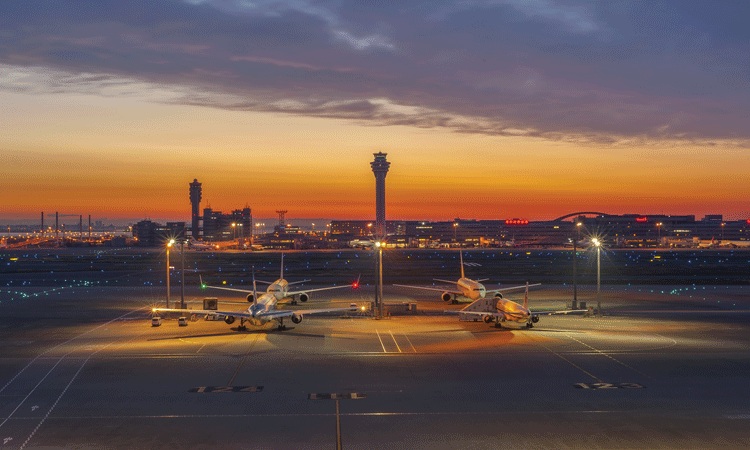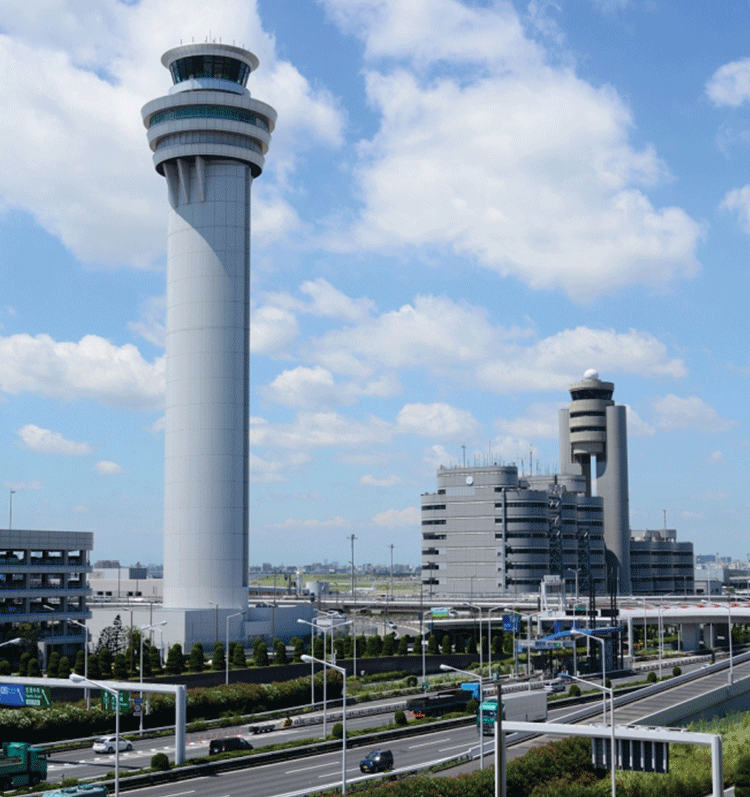Transforming Japan’s airspace
- Like
- Digg
- Del
- Tumblr
- VKontakte
- Buffer
- Love This
- Odnoklassniki
- Meneame
- Blogger
- Amazon
- Yahoo Mail
- Gmail
- AOL
- Newsvine
- HackerNews
- Evernote
- MySpace
- Mail.ru
- Viadeo
- Line
- Comments
- Yummly
- SMS
- Viber
- Telegram
- Subscribe
- Skype
- Facebook Messenger
- Kakao
- LiveJournal
- Yammer
- Edgar
- Fintel
- Mix
- Instapaper
- Copy Link
Posted: 12 April 2016 | Hitoshi Ishizaki | No comments yet
With aircraft movement capacity across Haneda International Airport and Narita International Airport expected to increase by 40,000 slots annually by 2020, the Japan Civil Aviation Bureau has been working closely with stakeholders to reorganise and review current air traffic control structures. Director General of the Japan Air Navigation Service, Hitoshi Ishizaki, reveals their strategy for the future of the region.


Tokyo/Haneda International Airport and Narita International Airport are two of the most representative international airports in Japan. Haneda is the busiest airport in Japan in terms of annual traffic volume and passenger volume, with domestic air services to 48 cities in the 2015 winter schedule. The airport also currently operates numerous international air services to 26 foreign cities in Europe, the Middle East, Asia, Oceania and North America. Haneda is located 15km from downtown Tokyo; the convenience of transportation access to the central metropolitan area is a great advantage for both tourists and business travellers.
On the other hand, Narita opened in 1978 as Tokyo’s primary international airport in order to accommodate ever-increasing demand of international air services in the metropolitan area. Upon the opening of Narita, the international flights were moved from Haneda to Narita. From the very beginning of its operation, most of the flights operated at Narita have been international air services. The airport still plays a role as the largest international airport in Japan with air services to several destinations. A distinctive feature of Narita is its rich network which, in the 2015 winter schedule, covered 106 cities worldwide.
Haneda and Narita are the gateway airports of Japan. These two airports are the pivot of passenger and cargo traffic flows connecting various cities in the world to Japan. In fiscal 2014, approximately 50% of foreign visitors to Japan used either Haneda or Narita – these airports are absolutely necessary social infrastructures for Japanese economic activities.
The Japan Civil Aviation Bureau (JCAB), Ministry of Land, Infrastructure, Transport, and Tourism, has taken various measures in order to strengthen the capacities of Haneda and Narita in terms of both expansion of metropolitan airspace and capacity increase of the airport infrastructure.
For instance, Haneda had only handled domestic air services since the opening of Narita as Tokyo’s international airport. However, JCAB decided to accommodate some of the international air services at Haneda upon commissioning Haneda’s fourth runway in 2010. Initially these were short-haul services to Seoul and Shanghai.
In addition, a new international passenger terminal was built at Haneda in 2014 to accommodate the increase of international passengers. As the result, Haneda’s aircraft movement capacity increased by 37,000 movements per year, totalling 447,000 per year, of which 90,000 are for international air services.
Meanwhile, JCAB successfully increased the capacity of Narita by introducing new air traffic control (ATC) operational procedures, such as Japan’s first implementation of simultaneous parallel departures and approaches, with associated new ATC infrastructures and ground facilities in 2011. To this end, Narita International Airport Authority (NAA) completed the construction of Terminal 3 ‘LCC Terminal’ to accommodate increasing demand of low-cost carriers. As the result, Narita’s aircraft movement capacity increased by 30,000 movements per year, today totalling 300,000 per year.
Consequently, the aircraft movement capacity of Haneda and Narita in total is 747,000 per year at present, which is higher than the capacity of most major international cities in the Asia and Pacific region.
The future of Haneda and Narita
Even with such efforts at Haneda and Narita, JCAB believes that Tokyo’s airport capacity needs to increase further in order to accommodate the ever-increasing demand of international air services, in terms of both aircraft movement and the number of passengers/cargo, by continuing to take every measure necessary to strengthen function of these two airports.
Prime Minister Shinzo Abe commented in his Policy Speech to the Diet in February 2015: “We will reinforce the functions of Haneda Airport, the gateway connecting Tokyo and the rest of the country. With the understanding of local people, flight routes will be revised, and the take-off and landing slots for international flights will be increased by 40,000 slots annually by 2020. Similarly, at Narita Airport we will sophisticate air traffic control functions and increase take-off and landing slots by 40,000 slots annually.”


The ATC tower at Haneda International Airport
In order to strengthen Tokyo’s global competitiveness and comfortably attract international visitors to Japan, as well as successfully and efficiently accommodate international air travellers particularly during the 2020 Tokyo Olympic and Paralympic games, JCAB has developed a plan for the further capacity increase of Haneda and Narita, and is energetically engaged in projects to carry out the plan, as discussed below.
Initially, in 2013, JCAB formed a group of specialists in academia, industry and government. After a series of technical meetings to discuss technical options to increase the capacity of the metropolitan area, primarily Haneda and Narita, the group published a report in the summer of 2014.
With regards to Haneda, the report identified a variety of measures to increase the capacity re-examining utilisation and flow patterns of the existing four runways. It also proposed an unprecedented introduction of low altitude arrival and departure routes over downtown Tokyo. Currently, due to noise abatement for densely-populated downtown Tokyo, JCAB establishes low altitude arrival and departure routes exclusively over Tokyo Bay. Consequently, Haneda’s traffic flows are concentrated over the narrow Bay area which is a current hurdle for drastically increasing the capacity of Haneda, particularly in the south wind configuration and the airport’s ATC capacity is 80 movements per hour.
The report proposes that the capacity may increase from 80 to 90 movements per hour by the establishment of arrival and departure routes over downtown Tokyo as well as re-examining the current ATC operation. JCAB considers that the annual capacity will increase by 40,000, as per the Prime Minister’s comments.
Such arrival and departure routes overfly densely-populated residential areas creating significant noise issues. In order to foster an understanding of the effected local communities, JCAB has been conducting local meetings to explain and communicate with the residents and local governments.
The report also indicated that, at Narita, the introduction of measures such as the sophistication of ATC systems and construction of additional high-speed taxiways may achieve an annual capacity increase of 40,000 movements by 2020.
In fact, JCAB has commenced sophistication of Narita’s ATC systems such as wide area multi-lateration (WAM) from March 2015. By the implementation of WAM, tower controllers are able to obtain accurate position information of departure traffic even under adverse weather conditions; enabling simultaneous parallel departures in instrument meteorological conditions (IMC).
JCAB has also been closely working together with the NAA to increase the capacity by the construction of additional high-speed taxiways. As a future plan after 2020, the construction of the third runway is being reviewed for further increase of the capacity at Narita.
Discussions with local governments and community are required, particularly at Narita, for any project to strengthen airport capacity. JCAB will continue to closely explain the plans and communicate with the stakeholders in a respectful manner to achieve various projects to capacity enhancement of Narita.
As capacity on the ground increases, the capacity in the air needs to be enhanced as well. JCAB plans to drastically review the ATC structures in the vicinity of the metropolitan airports in order to cope with the overwhelming traffic demand forecasted.
Airspace reorganisation
The total amount of traffic volume in the Fukuoka flight information region (FIR) has increased by approximately 150% in the past 15 years and JCAB estimates the traffic volume in the FIR will exceed its ATC capability by around 2025. The highest demand increase is expected to be by the international overflight traffic.
In order to deal with this situation, JCAB is planning a complete reorganisation of Area Control Centre (ACC) structures towards 2030. Presently, four ACCs – Sapporo, Tokyo, Fukuoka and Naha – handle in-route traffic in the Fukuoka FIR. Among the four ACCs, there are 42 domestic in-route sectors which are vertically partitioned.
In the past, as the traffic increased, in-route sectors were split into further small sectors in order to control the traffic volume/workload of each sector/controller at an appropriate level. However, JCAB now considers that further split of in-route sectors into smaller pieces will not enhance the capacity but rather decrease the productivity.
Therefore, instead of splitting the sectors vertically, JCAB has decided to introduce a horizontal split – upper airspace and lower airspace – introducing an upper ACC handing traffic higher than approximately 33,000ft which generally will control increasing demand of overflight traffic. The lower ACCs will handle mainly arrival and departure traffic to airports. JCAB plans to commission one upper ACC and two lower ACCs.
In addition to the ACC reorganisation, JCAB plans to combine terminal (approach) control airspace, which is currently designed by the concept of ‘one terminal airspace per airport’. By integrating a terminal control airspace into a larger terminal control airspace, JCAB expects that a much more efficient ATC service would be provided for departure and arrival traffic of neighbouring airports. By creating larger terminal control airspace and abolishing the terminal sector ‘boundary’, it is also expected that the efficiency of ATC service would be enhanced, such as establishing shortened departure or arrival flight paths.
In 2010, JCAB combined the terminal control airspace of Narita into Haneda and the approach control service of Narita is currently provided at Haneda. In order to cope with the further traffic increase by 2020, JCAB is planning further expansion of Haneda terminal control airspace; absorbing some airspace currently handled by Tokyo ACC. It is expected that the expansion of Haneda’s airspace would support further traffic increases to Haneda and Narita.
The capacity increase of Haneda and Narita is the biggest on-going challenge for JCAB in the field of air navigation services. Failure is not an option. We are committed to continuing efforts to successfully implement the projects described above with close collaboration with all stakeholders.


Issue
Related topics
Air traffic control/management (ATC/ATM), Airport development, Airside operations, Ground handling, Terminal operations


















